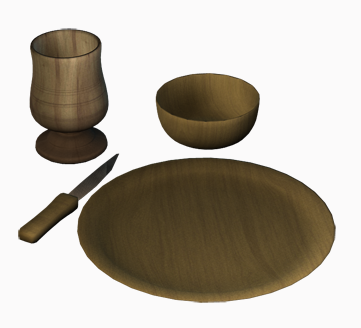Object Descriptions Tower House Parlor
Dinnerware
On the table sit wooden plates. The household may have used pewter plates instead. Spenser would have had a good diet consisting of different kinds of meat, including deer, sheep, domestic and wildfowl, goat and (more rarely) pork; seafood; various grains, particularly wheat, barley and oats; milk products; fruit and vegetables from an orchard and kitchen garden that he probably had (see Tower House Parlor: Apples); and probably honey and beer.
Other table objects here, in the Great Hall and in the Ground Floor Parlor are modeled after Tudor-era facsimiles in wood and pewter found at Barrycourt Castle, Co. Cork.

Bibliography:
Andrew Hadfield, Edmund Spenser: A Life (Oxford: Oxford UP, 2012): 218, 220-21.
Eric Klingelhofer, “Edmund Spenser at Kilcolman Castle: the archaeological evidence.” Post-Medieval Archaeology 39.1 (2005), 133-54.